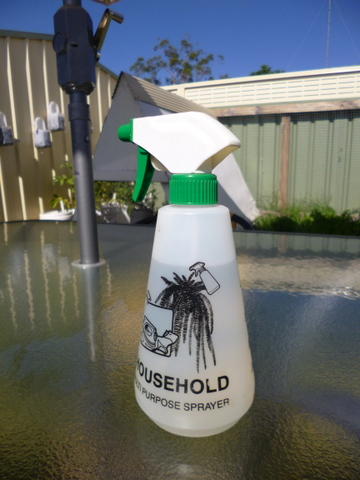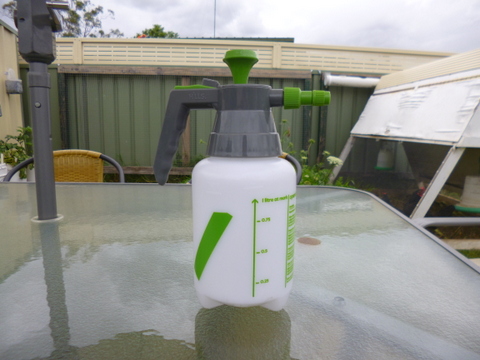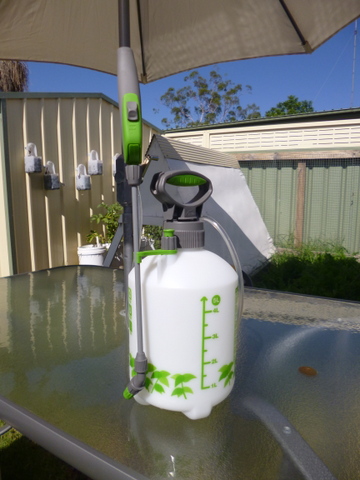By and large when you grow your food organically you try and avoid using sprays of any description, even the homemade or shop bought organic approved ones. Using cultural techniques and managing your pests by encouraging predators and keeping your plant healthy is by far the most preferable way. Unfortunately there are times when you have no choice, circumstances dictate that it’s either spray or face a crop wipe-out! It is like that at the moment here with the cabbage moth (not cabbage white butterfly), they usually turn up for a couple of weeks in February and are a pain but manageable. Last year they hung around a bit longer than usual due to the mild winter and they are here a bit early this year, I suspect due to the run of hot dry weather.
They were taking over and I was about to lose a whole stack of brassicas so I had to spray (as much as I didn’t want to)! The spray I intended to use was an “approved” organic spray being a bacterial spray, that is to say it is bacteria (bacillus thuringiensis) suspended in water to form the spray which is applied to the plants. It is available commercially under the name Dipel. It is a bacterium which only targets caterpillars and only if they eat the sprayed plants so it is very specific. It is important to spray in the late afternoon or early morning so that the bacteria can do their work before the UV of the sun kills them.
This of course raised a bigger question. What sort of sprayer should I get? The last one I had passed away over 10 years ago.
Which Sprayer?
There are whole stack of different sprayers on the market, if you only have a balcony sized area you might consider a bottom of the line “Household Multipurpose Sprayer” as shown below. One downside with this type of sprayer (apart from your hand getting tired pumping the trigger) is that the spray nozzle is very fine and particles can easily block it. Any commercial solutions to be sprayed such as pyrethrum spray would work out well but slurries such as sulphur or lime would block the nozzle very quickly. Also, while making and using homemade sprays is great some would need to be well filtered; milk or soap sprays would be fine, but any extract like the old standby chilli and garlic spray would need to be filtered through coffee filter papers before using or you may block the spray nozzle.
There is a slightly larger one available on the market which can be pumped up and so there is no tiresome trigger mechanism requiring to be pumped continually. It has a reservoir of about 2 litres and is designed for use with garden sprays. It doesn’t have a flexible nozzle so you need to angle it up under the leaves if required but they are readily available and quite inexpensive. For a dollar or two more you can have exaclty the same spray mechanism but with a 3 litre reservior.
The ones above didn’t really do it for me though, I needed something bigger, with a reservoir of about 5 litres, which would hold enough spray to do a decent job on the amount of stuff I grow. It would be heavier when full so I wanted a strap so I could carry it over my shoulder. I wanted a hose between the sprayer nozzle and the reservoir to give greater flexibility to spray under the leaves and an easily operable trigger. Seeing as it was going to be a pump up, it should be easily pumped up and have an overpressure relief valve as well. Thankfully the sprayer I got ticked all the boxes.
If you have a market garden sized veggie patch or really want to go heavy duty, you could buy a backpack sprayer. They will hold up to 20 litres but are expensive and heavy to lug around. They most likely would be far too large for even the most extensive back yard.
To decide on the best sprayer for your needs you should consider –
• What sprays you will be using (soluble sprays or slurries).
• The sorts of plants you need to spray
• How often you will need to spray, and
• The area of vegetation you intend to spray.
Mixing Sprays
All sprays will need to be diluted for use, make sure this is done in containers reserved for this purpose and they are thoroughly washed out prior to use. In general terms a good technique is to fill the sprayer half full of water, add in the required volume of spray concentrate, accurately measured, then top up with water. Replace the sprayer head and give the sprayer a good shake it should then be ready for use. If using a slurry spray and you take a break, give it another shake before you continue spraying.
Spraying Technique
To get the best out the spraying which you have to do and to minimise the risk of unintended consequences there are a few rules which should be followed –
1. Early morning or late afternoon when wind conditions are low is the best time for spraying, if you must spray during light winds always start downwind and work upwind.
2. Spray only the bits you need to – if the bug is underneath the top leaves, spray there, although fungal spray will need to cover the whole plant.
3. Don’t drench the plant with spray, only spray until discrete droplets can be seen covering the leaf. Several light applications are better than one heavy one.
4. When using a commercial spray dilute it as required on the label, a higher concentration will only waste spray and increase the withholding period ie the minimum time between spraying and harvesting.
5. When using pyrethrum based formulations avoid spraying plants in flower to reduce the likelihood of injuring bees.
6. Due to their nature, organic pesticides will breakdown quickly and may need to be re-applied in the case of a re-infestation.
Cleaning the Equipment
Once you have completed spraying it is very important to clean out and decontaminate the apparatus to prevent accidental contamination if somebody uses the sprayer for something else and just in case the next spray to be used is incompatible with the previous one.
The easiest way to do this is to flush the whole system through with water several times, wash out with a mild soap or detergent solution and then give a final rinse with clean water. If a slurry or particulate spray has been used, it is good practice to disassemble and clean out the spray nozzle to make sure no powder is caught within the spray nozzle itself.
Safety Concerns
Assume all pesticides, even the organic ones, are toxic and make sure that they are kept away from children and locked away when not in use. Always decontaminate spray equipment as above, including any containers used to mix up the spray, before locking it away after use. NEVER, EVER put any kind of spray into a food or drink container.
Disposal
Don’t leave unused spray material in the sprayer. For most home made sprays you can just pour it out on the ground or into a hole and cover with dirt, they will breakdown quite quickly, and then decontaminate your sprayer.
For those of you keeping score, I did apply the "Dipel"with my new sprayer, and it knocked the living daylignts out of the cabbage moth. Just one application and they were virtually wiped out!






